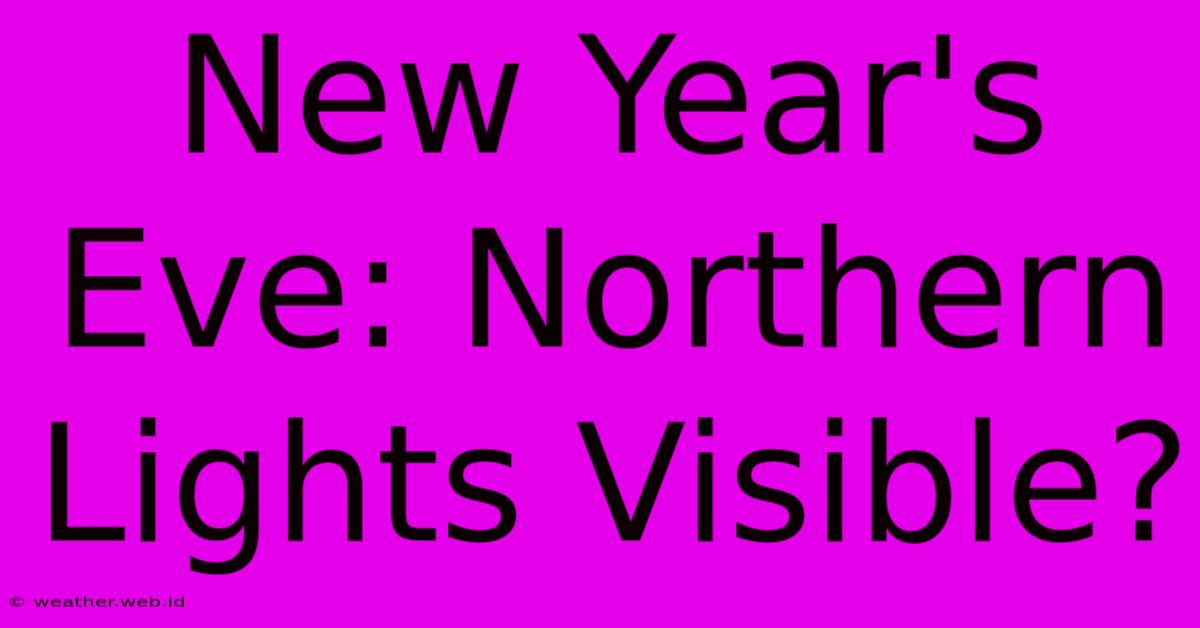New Year's Eve: Northern Lights Visible?

Discover more detailed and exciting information on our website. Click the link below to start your adventure: Visit Best Website weather.web.id. Don't miss out!
Table of Contents
New Year's Eve: Northern Lights Visible? A Guide to Chasing the Aurora
New Year's Eve. A time for celebration, reflection, and… maybe, just maybe, witnessing the breathtaking spectacle of the Northern Lights? The magic of the aurora borealis dancing across the night sky is a dream for many, and ringing in the new year under its ethereal glow? Unforgettable. But is it possible? Let's explore the chances of seeing the Northern Lights on New Year's Eve and how to maximize your opportunities.
Understanding the Aurora Borealis
Before we dive into the New Year's Eve possibilities, let's quickly review what causes the Northern Lights. The aurora is created when charged particles from the sun collide with atoms in the Earth's atmosphere. This collision releases energy in the form of light, resulting in the mesmerizing displays we see. The intensity and visibility of the aurora depend on several factors, most importantly solar activity and geomagnetic conditions.
Key Factors Affecting Aurora Visibility:
-
Solar Activity: The sun's activity fluctuates in an 11-year cycle. Periods of high solar activity increase the likelihood of strong auroral displays. You can monitor this through space weather websites and apps.
-
Geomagnetic Conditions: Even with high solar activity, geomagnetic storms are needed to push the aurora further south than usual. These storms are unpredictable, but again, space weather forecasts can offer valuable insight.
-
Light Pollution: City lights drastically reduce visibility. To see the aurora, you need a dark location far from urban areas.
-
Weather Conditions: A clear night sky is essential. Clouds will completely obscure the aurora.
New Year's Eve Aurora Chances: Location, Location, Location
While the aurora is unpredictable, some locations consistently offer better chances of viewing than others. These are typically within the auroral oval, a ring-shaped zone around the Earth's magnetic poles.
Top Locations for New Year's Eve Aurora Hunting:
- Iceland: Known for its stunning landscapes and frequent aurora displays.
- Norway (Tromsø, North Cape): Excellent viewing opportunities, with many organized tours.
- Finland (Lapland): Offers a unique combination of winter wonderland and aurora hunting.
- Sweden (Abisko National Park): Famous for its exceptionally dark skies.
- Canada (Yellowknife, Yukon): Vast, dark areas ideal for aurora viewing.
- Alaska (Fairbanks): Another excellent North American option with numerous viewing opportunities.
Increasing Your Chances: Planning Your Aurora Chase
While hoping for a spontaneous aurora sighting on New Year's Eve is fun, a bit of planning significantly boosts your chances.
Tips for Maximizing Your Chances:
-
Check the Aurora Forecast: Before you travel, and even daily during your trip, consult space weather websites for aurora forecasts. Apps and websites provide KP-index predictions (a measure of geomagnetic activity). A higher KP-index suggests a better chance of seeing the aurora.
-
Choose a Dark Location: Get away from city lights! The further you are from light pollution, the better your chances.
-
Be Patient: The aurora can be elusive. Be prepared to spend several hours waiting, and even then, there's no guarantee.
-
Dress Warmly: Winter nights in aurora viewing locations are extremely cold. Dress in layers, wear waterproof outerwear, and bring warm hats, gloves, and scarves.
-
Bring a Camera (Optional but Recommended): If you're lucky enough to witness the aurora, you'll want to capture the moment!
Conclusion: A New Year's Eve to Remember
Seeing the Northern Lights on New Year's Eve is a truly special experience. While there are no guarantees, careful planning and a bit of luck can significantly increase your chances. Remember to check aurora forecasts, choose a dark location, dress warmly, and most importantly, enjoy the magic of the night, regardless of whether you see the aurora or not. Happy New Year, and happy aurora hunting!

Thank you for visiting our website wich cover about New Year's Eve: Northern Lights Visible?. We hope the information provided has been useful to you. Feel free to contact us if you have any questions or need further assistance. See you next time and dont miss to bookmark.
Featured Posts
-
Blackhawks Winter Classic 2025 Date And How To Watch
Jan 01, 2025
-
Pitt Jolie Divorce Why So Long
Jan 01, 2025
-
Renowned Journalist Aaron Brown Passes Away
Jan 01, 2025
-
Todays College Football Games
Jan 01, 2025
-
Bowl Game Schedule 5 College Football Games
Jan 01, 2025
